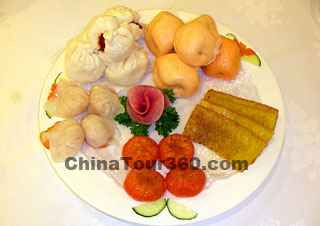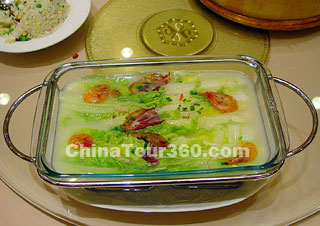Because of China's enormous size, varying climate and topography, and different customs, unique regional cuisines evolved and gained widespread acceptance. Initially, the most famous cuisines were Guangdong, Jiangsu, Shandong and Sichuan. Over time four major additional cuisines - Anhui, Fujian, Hunan and Zhejiang emerged to join the originals and form what is now known as the Eight Cuisines of China.
![]() Anhui Cuisine
Anhui Cuisine
It focuses much attention on cooking temperatures. Braising and stewing are preferred methods of preparation. Such diverse ingredients as caraway, ham and sugar are added to various dishes to improve taste and color. Many Anhui dishes feature aquatics. Representative dishes are Stewed Soft Shell Turtle with Ham; Huangshan Braised Pigeon and Braised Masked Civet.
![]() Fujian Cuisine
Fujian Cuisine
It is a blend of cooking styles from several of its provincial cities including Fuzhou, Xiamen and Quanzhou. Due to its coastal location, a wide variety of aquatics are available. Most Fujian dishes are served in soups and many have sweet and sour flavors. The sweetness brings out the freshness of the ingredients while the sour masks the aroma of the fish. Fujian chefs emphasize cleaning and cutting fish properly to enhance true flavors. Representative dishes are Buddha Jumping over the Wall (a complex dish including shark fin, abalone and shaoxing wine); Snow Chicken and Prawn with Dragon's Body and Phoenix's Tail.

Cantonese DimSum
![]() Guangdong Cuisine (Cantonese Cuisine)
Guangdong Cuisine (Cantonese Cuisine)
Guangdong is located in southern China and the food is recognized for its uniqueness and versatility. Snakes and leopards at one time were the most notable and unconventional ingredients used in some specialties. Modern Guangdong cuisine incorporates some western cooking techniques and has developed its own distinctive methods. Baking in salt, cooking in wine and soft-frying are approaches commonly employed by chefs. Guangdong cuisine has three branches: traditional; Chaozhou (similar to Fujian) and Dongjiang (or Hakka) which is characterized by strong flavors. Representative dishes are Baked Chicken in Salt; Roasted Suckling Pig; Shark's Fin Soup and Steamed Sea Bass.
![]() Hunan Cuisine
Hunan Cuisine
It consists of the local cuisines of the Xiangjiang River Valley, Dongting Lake and the western mountainous area. It is noted for its hot and spicy flavors and deep colors. Cooking methods emphasize stewing, pan-roasting, frying and smoking. Because Hunan is such a rich agricultural region, ingredients are plentiful and varied. Many recipes call for chili peppers, shallots and garlic. Representative dishes are Dongan Chicken; Peppery and Hot Chicken and Steamed Preserved Meat.

Braised Baby Cabbage in Broth
![]() Jiangsu Cuisine
Jiangsu Cuisine
Jiangsu cuisine, also called Huaiyang Cuisine, is popular in the middle and lower reaches of the Yangtze River. It consists of several styles including Nanjing, Suzhou and Wuxi. Primary cooking methods are braising, roasting and simmering. With aquatics as the main ingredient in most preparations, freshness is heavily stressed. It is also famous for its carving techniques particularly with melons. Many of its dishes use spices that impart a lightly sweet and salty taste. Representative dishes are Sweet and Sour Mandarin Fish; Stewed Crab with Clear Soup; Long-boiled and Dry-shredded Meat; Crystal Meat and Liangxi Crisp Eel.
![]() Shandong Cuisine
Shandong Cuisine
Modern Shandong cuisine evolved from Jinan, Jiaodong and Confucian cooking styles. Jinan is best known for its grilling and frying techniques; Jiaodong for its fresh seafood preparation and Confucian for being a courtly or aristocratic cuisine. Shandong preparations are characterized by freshness, aroma and tenderness. Recipes feature a wide variety of seafood and many different types of vegetables, especially onions and cabbages. Many Shandong dishes are a bit pungent owing to their use of indigenous vinegars. Unlike other parts of China, small grains are widely used here. Wheat, corn, sweet potato, soybean and millet are key ingredients in porridges, steamed breads and pasta.Representative dishes are Bird's Nest Soup, Yellow River Carp in Sweet and Sour Sauce, Braised Chicken Dezhou Style, and Braised Intestines in Brown Sauce.

Sichuan Hot-Pot
![]() Sichuan Cuisine
Sichuan Cuisine
Authentic Sichuan cuisine is a blend of the Chengdu, Chongqing and Yangtze styles. Known as 'Szechuan' in the west, Sichuan has one of the most famous Chinese cuisines in the world. Characterized by its spicy and pungent flavors, Sichuan recipes rely heavily on peppercorns, garlic, ginger, and fermented soybeans. It is said of Sichuan cuisine that 'one dish owns one style and a hundred dishes have a hundred tastes.' Its universe of tastes include spicy, hot, sweet, sour and garlicky. Dry frying, pickling, smoking and braising are the most popular cooking methods. It employs an extremely wide variety of ingredients with much dependence on wild vegetables and meat. Representative dishes are Hot Pot, Pork Lungs in Chili Sauce, Yu-Shiang Shredded Pork in Spicy Garlic Sauce, Kung Pao Chicken and Mapo Tofu (Stir-Fried Tofu in Hot Sauce).
![]() Zhejiang Cuisine
Zhejiang Cuisine
Comprising the specialties of Hangzhou, Ningbo and Shaoxing, Zhejiang cuisine is noted for its freshness, tenderness and fragrant aromas. Hangzhou is the most famous of the three and emphasizes seafood, shellfish and a variety of seasonal vegetables. Ningbo focuses on freshness highlighting the original flavor of its ingredients. Shaoxing relies on ingredients from near the rivers and the sea. Its dishes have a unique rural flavor and sometimes use thick gravies. Representative dishes are West Lake Fish in Vinegar Gravy; Longjing Shelled Shrimp and Beggar's Chicken.







